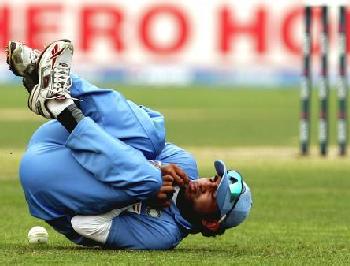What everyone ought to know about limited overs
It's an increasingly common site across the cricket fields of the world: Games without draws. These games are a totally different way of playing with their own challenges for cricketers, especially captains.
The essential difference between the two forms is that you don't need to bowl the opposition out to win. This means you are looking to defend in the field far more quickly, ideally using the basic field placing structure to cut off as many runs as possible in the V.
How to get more wickets with spin
It's a little known fact that most club cricket games are won and lost with spinners.
The reason is that most club batsmen tend to have a decent defence and not many shots while most club seamers tend to not be good enough to fire out the opposition.
That leaves the spinner to step in. You ready for the challenge?
Want a great way to develop potential captains?

Captaincy is the hardest cricket skill to learn because the only way to get better at it is to actually be a captain. But if you have no experience, how are you going to get the job?
One way around this problem, and motivate younger players, is for established captains to hand a little bit of responsibility to his younger players for a short period.
What are Michael Vaughan’s views on captaincy?
Today I have been reading Michael Vaughan's book 'Calling the Shots' about his time as England captain and something he wrote struck me.
Although he doesn't go into a lot of detail about the nuts and bolts of captaincy, he does give an insight on what it's like to be a captain, which is very like the post I did on club captaincy.
9 Club cricket myths
- Some teams always play for the draw. Too many times a captain will blame the opposition for a boring draw. There are very few sides who deliberately aim to go for the bore draw. More likely, neither captain has taken control of the game enoughto keep it close. The answer: Be prepared to take a risk. You will play in a lot less draws.
Can bad fielders hide?

It's a perennial problem from Test cricket to club level: What do you do with the folks that cant run, throw or catch?
The issue has kept Monty Panesar from the England ODI side and keeps chunky middle-aged blokes in the slips for years. But its a problem that club captains can overcome.
The answer is this: put them in places the cricket ball is unlikely to go. Not much of a secret then. But the real mastery to this trick is to do it subtly, so the opposition doesn't realise what you are up to. So instead of putting your rabbit at mid on automatically, consider these options.
A few notes on field placing
If you are a captain or bowler the chances are that you agonise over setting the right field.
While the wrong field can be a disaster, the right one can make the difference between winning and losing. Especially in lower scoring games. So mastering the basics is essential. As is being able to think on your feet and change your ideas and plots at a moments notice. Perhaps even every ball.
With that in mind, here are some general notes on how to place the field.
Why aren’t you getting more wickets?
If you have ever bowled or captained, you are sure to have asked yourself: Where are we going to get 10 wickets from today?
It's rare in club cricket to have bowlers good enough to knock a side over one their own, so you have to use every trick in the book.
You already know the main ploy: Risk losing in order to win. Now you need to convert that to real life tactics:
How you can control the result of your club game
What are the basic principles behind your tactics on the cricket field?
How do you turn those principles into real life field placings, bowling changes and wins?
Each game may be different, but one thing always remains the same: You must always be trying to win, even at the risk of losing.
But that idea, no matter how sound, is not enough in itself. Here are the practical principles that lie underneath:
Controlling the game: Fielding 2nd
10 ways to avoid boring club cricket draws

image credit: ervine_wa
How many times have you played a club game where the scores are something like 227/5 dec. and 158/7 at stumps: Totally one sided and totally dull?
Dull draws can be avoided if the captain knows what he is doing and has the confidence to control the game.
So if you are a captain or bored player and want to know how to dodge draws and not waste your weekend afternoons blocking out, then read these top tips.

